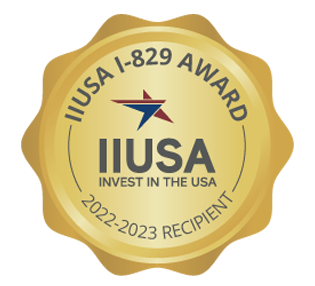The EB-5 visa program is the United States version of Golden Visa. It provides a unique opportunity for foreign nationals to attain U.S. permanent residence or green card by making a qualifying investment.
What is the EB-5 Visa Program?
The U.S. Congress created the EB-5 visa program in 1990 to attract foreign direct investment into the United States. The program offers U.S. permanent residence or a green card to high-net-worth individuals (HNIs) and their qualifying dependents who make a qualifying investment in the United States. The program is aimed at creating American Jobs, and in order to qualify, the funds invested by an EB-5 investor need to create 10 new full-time American Jobs. The minimum qualifying investment amount is $800,000 in a Targeted Employment Area (or also known as TEA) and $1,000,000 in areas that are not designated as TEAs. In November 2019, for a brief period of time, the investment amount was increased to $900,000 in TEAs and $1.8 million in non-TEAs. However, the change was challenged in a federal court and the amount was reverted to its original number in June of 2021. At present, the U.S. Congress is considering increasing the minimum investment amount and reducing investment gap between TEAs and non-TEAs.
What are the Qualifications to Become an EB-5 investor?
To qualify as an EB-5 investor, the foreign national needs to meet the requirements of being an Accredited Investor under Regulation D of the U.S. securities laws. To be an accredited investor, EB-5 investor must meet the following requirements:
- Have an individual net worth, or joint net worth with your spouse or spousal equivalent, of more than $1 million at the time you purchase an interest less the value of your primary residence, or
- Have an annual individual income of more than $200,000 or annual joint income with your spouse or spousal equivalent of more than $300,000 in each of the preceding 2 years and a reasonable expectation of the same level of individual or joint income in the current year.
Who are Considered Qualifying Dependents in an EB-5 petition?
Qualifying dependents under an EB-5 petition are EB-5 investor’s spouse and unmarried children below the age of 21 year at the time of filing the petition.
What is the Process for Receiving a Green Card under the EB-5 Visa Program?
Obtaining U.S. permanent residence or green card is a multi-step and multi-year process. It is more involved than filing immigration forms online like in the case of visitor visa or student visa. EB-5 investors are highly encouraged to engage an immigration attorney to guide them through the EB-5 visa process. An immigration attorney plays a key role in documenting the source and path of funds being invested by the EB-5 investor. This attorney is also responsible for conducting immigration due diligence of the project.
Here are the main steps for obtaining U.S. permanent residence or a green card through the EB-5 visa process:
- Prepare and File Application for Conditional Green Card (also known as I-526 Petition)
The documents submitted for this petition demonstrate that:- The required capital has been invested in a New Commercial Enterprise (NCE)
- The investment capital was obtained by the investor through lawful means
- The new commercial enterprise will create or has created at least 10 new full-time American jobs
- The investor is a member of the NCE
- Application for Conditional Green Card or I-526 Petition Approval
- After the U.S. Citizenship and Immigration Services (USCIS) approves the application for a conditional green card or the I-526 petition, (i) EB-5 investors outside the United States are required to complete their documentation requirement and pay the requisite fee to schedule an interview with the local U.S. Consulate. Once the interview is conducted, the Consulate stamps the passport with an immigrant visa. The immigrant visa has a validity of 6 months. EB-5 investors must travel to the United States within 6 months to activate their conditional permanent residence and receive their conditional green card and (ii) if the EB-5 Investor is in the United States, his/her immigration attorney will assist him/her in filing an application for adjustment of status or I-485 (also known as Application to Register Permanent Residence or Adjust Status). While USCIS has the authority to call the EB-5 investor for an interview, in majority of the cases, the interview is waived, and the EB-5 investor receives the conditional green card in mail.
- The conditional green card gives the holder the same benefits as an unconditional or a regular U.S. green card.
- Application for Removal of Conditions or I-829 Petition
- After spending 1 year and 9 months (21 months) on a conditional green card and before the expiration of 2 years (24 months), the EB-5 investor through his/her immigration attorney is required to file an application for removal of conditions. In this application, the EB-5 investor needs to demonstrate that:
- The required amount of capital was fully invested in the project.
- The project did not deviate from the business plan submitted with USCIS with the I-526 petition.
- The project created 10 new full-time American jobs.
- Upon receipt of the petition, USCIS issues a receipt notice to the EB-5 investors. This notice automatically extends the conditional permanent residence by 18 months to keep the EB-5 investor in valid status while USCIS processes the petition.
- After spending 1 year and 9 months (21 months) on a conditional green card and before the expiration of 2 years (24 months), the EB-5 investor through his/her immigration attorney is required to file an application for removal of conditions. In this application, the EB-5 investor needs to demonstrate that:
- Return or Redeployment of EB-5 Capital
- Once the EB-5 investors satisfy the requirements as per the offering documents of the project, EB-5 investors will receive their invested funds back upon meeting the following conditions:
- Completion of 2-year conditional permanent residence period
- Repayment of the respective portion of the EB-5 loan by the borrower
- Sometimes due to inordinate delays in processing of applications or consulate closures, EB-5 investors are unable to meet the 2-year requirement of conditional permanent residence. This may trigger redeployment of funds, i.e., the borrower has repaid the EB-5 capital to the fund entity but the same cannot be repaid to the EB-5 investors without jeopardizing such investors’ immigration.
- Once the EB-5 investors satisfy the requirements as per the offering documents of the project, EB-5 investors will receive their invested funds back upon meeting the following conditions:
- I-829 Petition Approval and Unconditional Green Card Issuance: Once the application for removal of conditions is approved, USCIS will mail the unconditional green card to the EB-5 investor’s address on file. The unconditional green card has a validity of 10 years and can be renewed infinite number of times during the lifetime of the EB-5 investor if the investor has not abandoned U.S. permanent residence.
- U.S. Citizenship: Upon spending 5 years from the day of receipt of conditional green card, EB-5 investors are eligible for U.S. citizenship upon fulfilling certain conditions such as spending 30 months in preceding 5 years in the United States without a gap of more than 6 months at a stretch.
How Long will It Take to Receive your EB-5 Visa?
The processing time in the graphic are suggestive and may vary based on USCIS workload, unforeseen global events like the COVID-19 pandemic, and personal circumstances of the EB-5 investors.
Change in I-526 Processing
The timeline for issuance of immigrant visa under the EB-5 visa program greatly varies depending on the country of birth of the EB-5 investors. On January 29, 2020, USCIS announced a shift in the approach from “first-in first-out” to a “visa availability” for adjudicating applications for conditional green cards or I-526 petitions. This shift impacted Mainland China-born investors as it is the only country that has grossly oversubscribed EB-5 visa resulting in non-availability of EB-5 visas for Mainland China-born applicants for the foreseeable future and triggered long term retrogression. Non-adjudication of such petitions has led to addition of many years to Chinese petitions.
Document Preparation
- 30 to 60 days depending on the complexity of source of funds.
Invest and File Application for a Conditional Green Card or I-526 Petition
- Day 1 of EB-5 visa process.
Approval of Application for a Conditional Green Card or I-526 Petition
- EB-5 Investors should take at least 2 years of processing time into consideration.
- Timeline varies greatly. The USCIS average is distorted because of non-processing of Chinese applications.
Consulate Interview or Adjustment of Status and Receipt of Conditional Green Card
- If the applicant is outside the United States, they need to submit documentation and schedule an appoinment with the local U.S. Consulate. This takes on average between 6 months to 12 months.
- If the applicant is in the United States, they need to file an application for Adjustment of Status or I-485 (also known as Application to Register Permanent Residence or Adjust Status), this also takes on average between 6 months to 12 months.
Filing of Application for Removal of Conditions or I-829 Petition
- Filed after 21 months of receipt of conditional green card and before the expiration of 24 months.
Repayment of EB-5 Capital
- After completion of 24 months from the receipt of conditional green card and repayment of the respective portion of the EB-5 loan by the borrower depending on the EB-5 loan term (usually 5 years).
Receipt of Unconditional Green Card
- 24 month to 36 months.
- During the processing of the application for removal of conditions the validitity of Conditional Green Card is extended.
For more information on GGG and EB-5, please follow us on YouTube, Twitter, Facebook, LinkedIn and Instagram.


